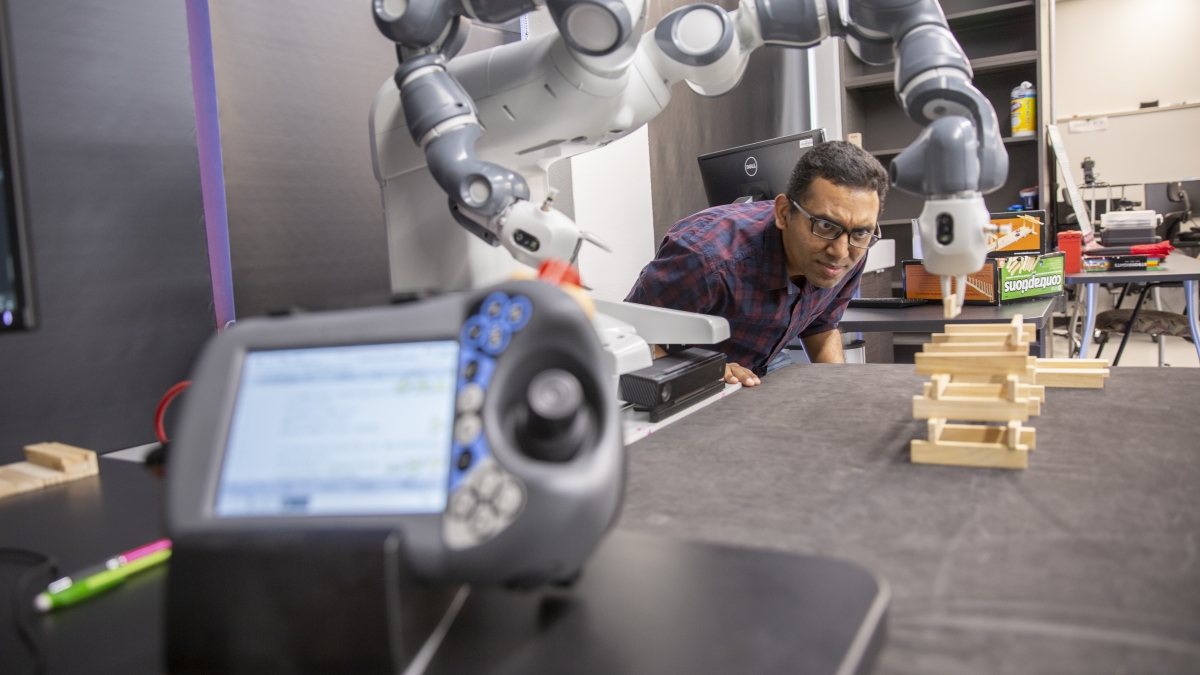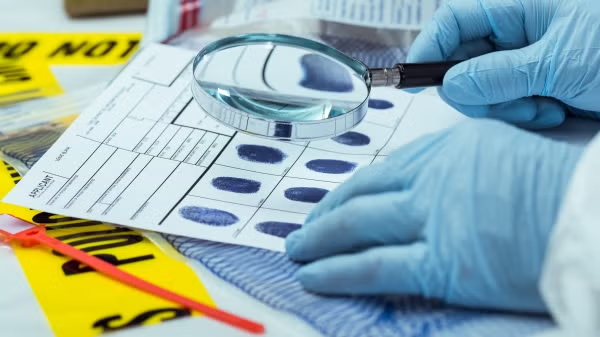Robot coworkers: How AI impacts the future of work

Pulkit Verma, a graduate student member of Siddharth Srivastava’s research team, helps with efforts to reprogram autonomous robots using artificial intelligence. The new robots will not only be more adaptable to the manufacturing industry as it evolves, but they will also be equipped with intelligent tutoring systems to train factory workers to operate the robots. Photo by Erika Gronek/ASU
What happens when technology advancements threaten to automate people’s jobs?
That question is on the minds of many as research and development in artificial intelligence and machine learning rapidly advances.
A new project led by Siddharth Srivastava, an assistant professor in the School of Computing, Informatics, and Decision Systems Engineering at Arizona State University, aims to help alleviate this concern.
Srivastava and his multidisciplinary team are creating autonomous systems that are not only more adaptable and efficient in manufacturing environments, but also have built-in intelligent tutoring systems that will cooperate with factory workers and retrain them to use AI technology so they are not displaced from their jobs.
Funded by a $1 million grant from the National Science Foundation as one of its Convergence Accelerator awards, the project is highly focused on using AI to augment the workplace rather than replace workers.
“Suppose you have this new robot, it’s very efficient, but you need to hire five computer science graduates to operate and maintain it instead of five current factory workers,” Srivastava said. “That’s not feasible, first of all because we don’t have that many computer science graduates in society. Our idea is that instead of getting people to enroll in a new college program again, what we can do instead is design our AI systems, our robots, in a way that will help people to come on board.”
Srivastava is collaborating with ASU faculty members in the Ira A. Fulton Schools of Engineering and the School for the Future of Innovation in Society to bring the project to life.
“We have 10 team members, including experts in robot control, tutoring systems and human systems engineering — a field that involves thinking about how the robot and the human would interact and how you would build a situation where the human trusts the robot,” Srivastava said. “We also have experts in law to help solve the sociotechnical aspects of the problem.”
How artificial intelligence can preserve jobs
Traditionally, AI has mostly been developed with a mind to automate human-performed tasks — that is, to perform tasks in place of a human. For example, machines play chess better than humans do and are also faster at distinguishing patterns and performing calculations. One example of AI working to augment human-performed tasks rather than replace them can be found in intelligent tutoring systems.
The ASU team is focusing on this interaction, particularly in implementing the intelligent training systems for factory workers. This eliminates the concern about driving up the demand for highly educated workers to unsustainable levels and also empowers human workers to incorporate AI into their work.
According to Subbarao Kambhampati, a professor of computer science, this education-based relationship is the key to successful collaboration between AI and humans. In particular, the AI systems need to learn to model the mental states of the humans they collaborate with, and use those models to guide their interactions with the humans.
“We are now considering scenarios in which the AI system teaches humans on the job,” Kambhampati said. “If you are using one machine, and there is a big technological advancement, then the question is what is the best way to get people to come up to speed in using these new machines?”
This retraining process is essential to helping factory workers in the evolving manufacturing industry keep their jobs. It’s a necessary transition into a future when machines can augment human activities without replacing the people who have traditionally performed them.
In that scenario, workers would be able to assign robots a wider variety of tasks while the robots teach workers how to use the robots and why robots are making the decisions they do.
“(Robots) are more adaptable in that their behavior adapts to the changes in their environment, they adapt to the tasks that you give them and at the same time they can answer your questions,” Srivastava said. “A worker who doesn’t know the internals of the robot can ask it, ‘Why did you go along this path when I think you should have just gone straight?’ And the robot can answer, ‘If I go this way then my hand might collide with that table.’ So, in that process, the worker learns about the robot’s constraints and how to operate it.”
Moving toward a more robotic future
Could machines ever replace humans? Is it cheaper to have an all-robotic workforce?
The answer is complicated, said Katina Michael, a professor jointly appointed in the School for the Future of Innovation in Society and the School of Computing, Informatics and Decision Systems Engineering, one of the six Fulton Schools.
“At face value, initially it seems that robots would do better than the operational expenditure of the human labor force,” she said, “but when you look at this quite clinically, you’re almost shifting costs from the human labor force to the robotic labor force. It’s quite debatable as to whether costs will be reduced.”
While robots can operate 24/7, people need breaks, time off, insurance coverage and compensation. However, robots must be updated and maintained, and they also need power to operate — human workers are still extremely necessary in the workplace.
Although the research project is focused on AI development, it is ultimately centered around training human workers and ensuring job security. The team wants to enhance communication between both humans and robots to obtain the best of both worlds in the manufacturing industry.
“Sadly, training diminishes with the increased cost of the capital investment,” Michael said. “Many corporations are trying to save money somewhere, but training is where we need to invest more money in order to have a successful integration of workers and autonomous systems so we can minimize safety risks. If we don’t have adequate training, we don’t have adequate responses to reducing the incidence of on-the-job disasters.”
An interdisciplinary interaction
In highly multidisciplinary projects involving diverse skill sets and expertise in multiple areas, there are many factors to consider when humans team up with robots.
“We’re interested primarily in how humans and robots work together,” Michael said. “With the humans doing their bit and the robots doing their bit, we want to see if there is any incongruousness or congruousness that can be observed. I’m also looking not only at the economic impact but also the societal impact, seeing if the workers who are interacting with these robots are receiving adequate training.”
Erin Chiou, an assistant professor of human systems engineering at The Polytechnic School, one of the six Fulton Schools, is studying the interactions of humans and machines for data to guide the design of systems that prioritize the collaboration of humans and robots.
“Ultimately, it’s getting that multidisciplinary conversation going between people who actually build the machines and people who think very critically about job design and human workers,” Chiou said. “It is relatively easy to optimize technology when you aren't thinking too deeply about how to involve people, because once you involve people, you introduce variation into the system. This makes the problem much more difficult. At the same time, this variation — or the ability for a system to adapt to different situations — is crucial for technology acceptance and for overall system performance.”
The ASU team also has experts looking at the legal, social and economic implications of implementing such technology in the workplace, all of which will be considered when designing the new systems.
“It’s not about changing the hardware, it’s about how to change the software,” Srivastava said. “We’re thinking about how it should act and what it should do. We are rethinking how a robot’s ‘mind’ should work in order to make it more amenable to providing on-the-job training and collaborating with humans.”
More Science and technology

A spectacular celestial event: Nova explosion in Northern Crown constellation expected within 18 months
Within the next year to 18 months, stargazers around the world will witness a dazzling celestial event as a “new” star appears in…

ASU researcher points to fingerprints as a new way to detect drug use
Collecting urine samples, blood or hair are currently the most common ways to detect drug use, but Arizona State University…

Learn about the secrets of forensic science straight from the experts
Over the next week, true crime enthusiasts will have a rare opportunity to discover the secrets of forensic science as experts…

